kimmik
Well-known member

The prism is the heart of a prismatic binocular, the most critical piece of the technology that converts an inverted and inaccessible image, to a natural extension of the eye of the expected orientation and light path. This is achieved through reflections, many reflections, especially if one wishes to look straight through rather than at 45° or 90° to the source of the light. In the search for the big eyes experience, the ultimate augmented reality, an immediate extension of the mind and body, is Schmidt Pechan the future?
Zeiss seems to think so, having nearly fully converted the premium line up to SP. Leica tried for a modern Uppendahl but eventually went with SP. Swarovski has been nearly all in on SP for a long time now. Nikon also, with the EDG being SP, added a giant Abbe Koenig WX as a halo product which is impractical for handheld use (for most).
Porro being the grand father of prismatic binoculars, was thought to be fully matured until Perger patented a version which is water proofable - great, but here is the problem, it is the same problem as why Abbe Koenig is phased out. It is too elegant, too simple, too perfect, with too few reflections, and that is bad for two big reasons:
1. less reflections means the binocular will be too long, lacking compactness. This wasn't noticeable before ED glass, as the focal length was quite long anyway.
2. it is already optically perfect, with little room to improve. I even wonder, whether Zeiss at least, knew of this design all along, as it seems to be a roofless and narrower FOV version of abbe-koenig.
With Abbe Koenig, one of the final iterations being the Zeiss FL, was considered by Zeiss to be too good to be made with metal. It was downgraded to plastic housing which will slowly leave circulation and make room for the next era of Zeiss binoculars, the Schmidt Pechan.
Schmidt pechan uses 6 reflections, lengthening the light path with sideways bounces, while shortening the physical length. The latter is desirable, while the former is where magic separates "alphas" from the "good". This separation is what the current premium brands live on. If they were making traditional porros, they would struggle to differentiate themselves with the newer makers who have caught up with broadband multicoat antireflection. I think we will see AK and UP return in 20 years, when mass market SP has caught up sufficiently that Zeiss and Leica need a new way to differentiate themselves, then these inherent strengths will be of value.
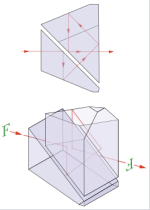
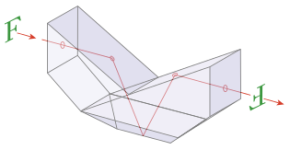
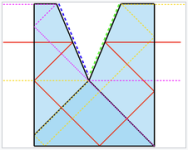
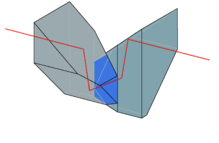
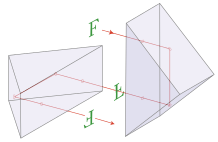
By Fred the Oyster, CC BY-SA 4.0, File:Schmidt-Pechan prism.svg - Wikimedia Commons
By Fred the Oyster, CC BY-SA 4.0, File:Abbe-König prism.svg - Wikimedia Commons
By Holger Merlitz - Own work, Copyrighted free use, File:Uppendahl prisma randstrahlen.png - Wikimedia Commons
By Merlitz (Diskussion) - Own work (Original text: Selbst erstellt, nach Vorlage der Patentschrift EP2463692A1 künstlerisch erweitert), Public Domain, File:Perger prisma.png - Wikimedia Commons
By Fred the Oyster, CC BY-SA 4.0, File:Double Porro prism.svg - Wikimedia Commons
Zeiss seems to think so, having nearly fully converted the premium line up to SP. Leica tried for a modern Uppendahl but eventually went with SP. Swarovski has been nearly all in on SP for a long time now. Nikon also, with the EDG being SP, added a giant Abbe Koenig WX as a halo product which is impractical for handheld use (for most).
Porro being the grand father of prismatic binoculars, was thought to be fully matured until Perger patented a version which is water proofable - great, but here is the problem, it is the same problem as why Abbe Koenig is phased out. It is too elegant, too simple, too perfect, with too few reflections, and that is bad for two big reasons:
1. less reflections means the binocular will be too long, lacking compactness. This wasn't noticeable before ED glass, as the focal length was quite long anyway.
2. it is already optically perfect, with little room to improve. I even wonder, whether Zeiss at least, knew of this design all along, as it seems to be a roofless and narrower FOV version of abbe-koenig.
With Abbe Koenig, one of the final iterations being the Zeiss FL, was considered by Zeiss to be too good to be made with metal. It was downgraded to plastic housing which will slowly leave circulation and make room for the next era of Zeiss binoculars, the Schmidt Pechan.
| Schmidt Pechan | Uppendahl | Abbe Koenig | edit: Mirror-AK? | Perger Porro | Porro | |
| Reflections (total number) | 6 | 6 | 4 | 4 | 4 | 4 |
| Perfect total internal reflection TIR | 0 | 1 | 2 | 0 | 4 | 4 |
| Imperfect TIR | 5 (2 phase, 3 AR) | 4 (2 phase, 2 AR) | 2 (phase coated) | 2 (phase coated) | ||
| Mirror reflection | 1 | 1 | 2 | |||
| Pure transmission surfaces | 1 | 4 (0 if cemented) | 4 (2 if cemented) | 2 | 4 (2 if cemented) | 4 (2 if cemented) |
| Partial transmission surfaces | 3 | 2 | 0 | |||
| Compactness in order | A | B | C | B/C | D | E |
Schmidt pechan uses 6 reflections, lengthening the light path with sideways bounces, while shortening the physical length. The latter is desirable, while the former is where magic separates "alphas" from the "good". This separation is what the current premium brands live on. If they were making traditional porros, they would struggle to differentiate themselves with the newer makers who have caught up with broadband multicoat antireflection. I think we will see AK and UP return in 20 years, when mass market SP has caught up sufficiently that Zeiss and Leica need a new way to differentiate themselves, then these inherent strengths will be of value.





By Fred the Oyster, CC BY-SA 4.0, File:Schmidt-Pechan prism.svg - Wikimedia Commons
By Fred the Oyster, CC BY-SA 4.0, File:Abbe-König prism.svg - Wikimedia Commons
By Holger Merlitz - Own work, Copyrighted free use, File:Uppendahl prisma randstrahlen.png - Wikimedia Commons
By Merlitz (Diskussion) - Own work (Original text: Selbst erstellt, nach Vorlage der Patentschrift EP2463692A1 künstlerisch erweitert), Public Domain, File:Perger prisma.png - Wikimedia Commons
By Fred the Oyster, CC BY-SA 4.0, File:Double Porro prism.svg - Wikimedia Commons
Last edited:







